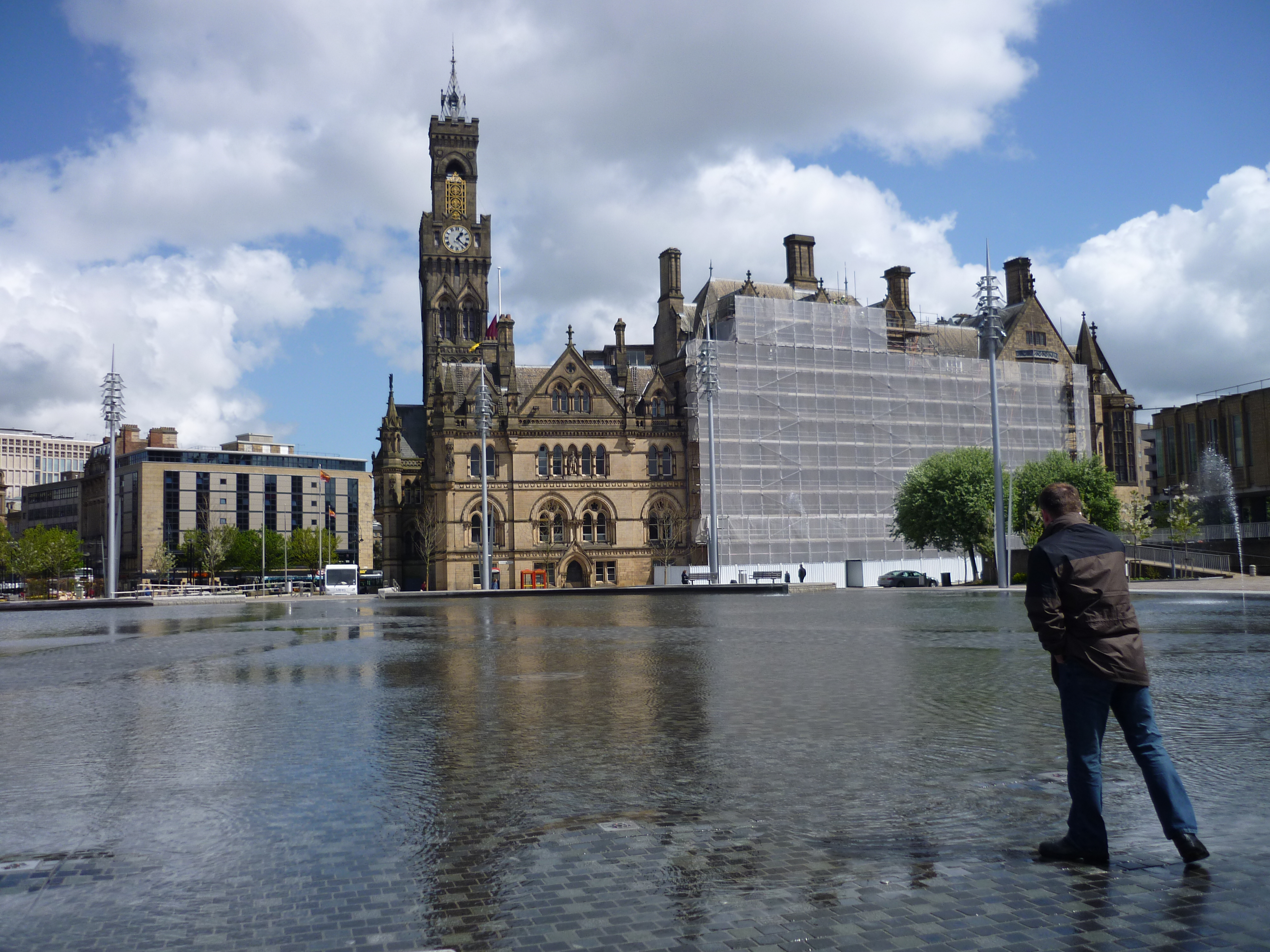 Here’s Bradford’s city centre Mirror Pool, the City Hall behind it, yesterday afternoon as the sun shone. In the foreground is Andy from Pro-Audio, on the phone trying to figure out why he can’t get control of the fountains at his lighting desk. We were setting up for last night’s Blue Mirror performance – commissioned by Bradford Council’s Chief Drainage Engineer Tony Poole, to help open the Flood ResilienCity conference taking place in this city this week, with delegates from across Europe (don’t ask me about the weird spelling…). I’m such an idiot that this is the only picture I remembered to take – I got a bit preoccupied with just getting the show to happen – so we’ll have to wait for Simon Warner’s official pics to see what it all looked like… (from his point of view)
Here’s Bradford’s city centre Mirror Pool, the City Hall behind it, yesterday afternoon as the sun shone. In the foreground is Andy from Pro-Audio, on the phone trying to figure out why he can’t get control of the fountains at his lighting desk. We were setting up for last night’s Blue Mirror performance – commissioned by Bradford Council’s Chief Drainage Engineer Tony Poole, to help open the Flood ResilienCity conference taking place in this city this week, with delegates from across Europe (don’t ask me about the weird spelling…). I’m such an idiot that this is the only picture I remembered to take – I got a bit preoccupied with just getting the show to happen – so we’ll have to wait for Simon Warner’s official pics to see what it all looked like… (from his point of view)
The brief had been to make a theatrical presentation for the Mirror Pool, on flood-related themes… In keeping with my own creative interests, I had interpreted this in site-specific terms, on two levels: (1) the Mirror Pool area is a site in which you frequently see children splashing about having fun, so it seemed to me that an appropriate creative response would involve children as performers; (2) that Bradford’s flood risk problems largely arise in areas where the river itself is invisible – submerged beneath the city in Victorian tunnels. Indeed the Beck actually passes by quite quote to the Mirror Pool, which according to the maps is in the risk area – yet the Mirror Pool (opened last year at a cost of millions) is the only water visible in the area. So I had set out to devise a performance that “made visible” something of the Bradford Beck river system, by thinking of the Pool as a kind of microcosm of the city…
With the help of the Council, we identified two primary schools in the west of Bradford – St. James and Crossley Hall – that were interested in participating in a project about rivers and flooding, leading to a performance. I wrote a previous blog entry about my scouting trip along Pitty Beck and Chellow Dean Beck, the two tributaries of Bradford Beck that pass near the schools. Subsequent to that visit, before the Easter holidays, I led two Year 5 classes from Crossley Hall on adventure trips along Chellow Dean, upstream towards the old Victorian reservoir — although on the second occasion we didn’t get that far because we got caught in a snowstorm and had to turn back! In fact in this picture below, if you look closely, you can see class teacher Miss Taylor gesturing with her thumb to pull everybody back in the opposite direction…
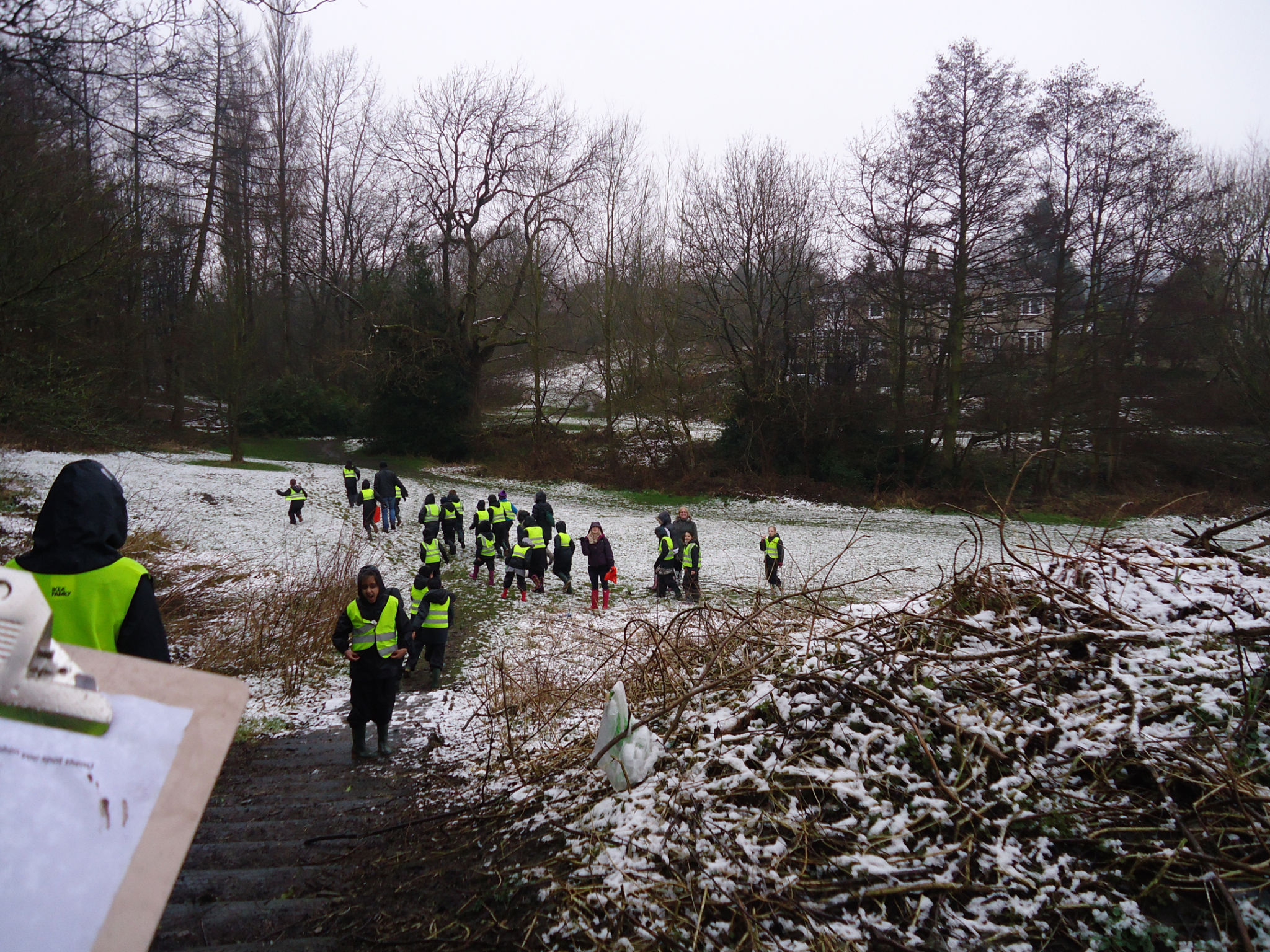
Only minutes earlier it had been much less snowy, as you can see from this image (taken by Miss Taylor, I think – who kindly supplied all of the pictures below), as the some of the children and I pick our way across the stream in the Chellow Dean wetlands area…
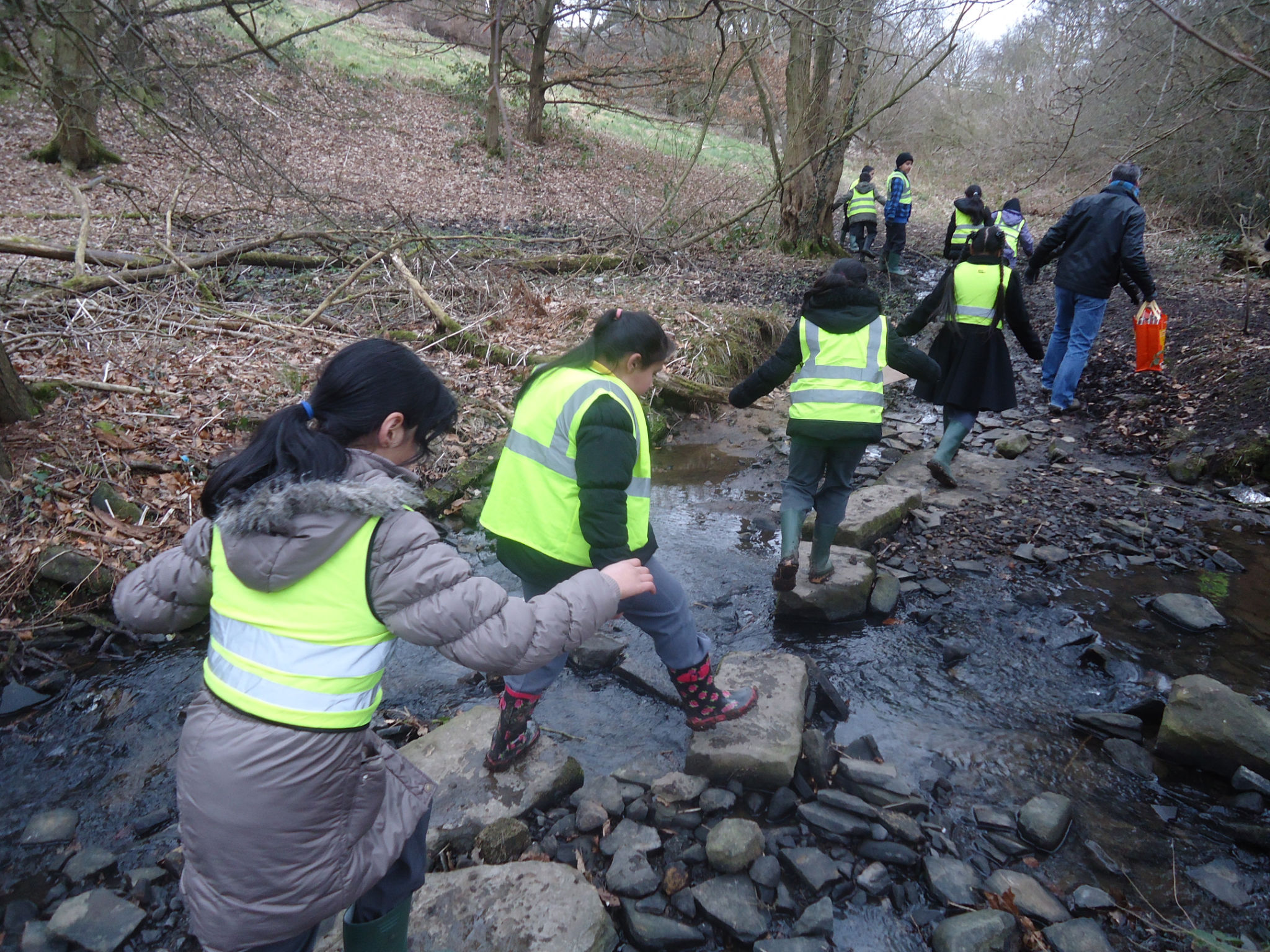 In fact, the weather got so terrible in that period just before the Easter break that I twice had to cancel the planned walk along Pitty Beck with the St. James Year 5 class, which we only finally did a few weeks ago. As a result, St. James have only been doing their river project work this term – too late to feed it directly into making the performance itself. The Crossley Hall children, however, did some beautiful natural art work in response to the river trip…
In fact, the weather got so terrible in that period just before the Easter break that I twice had to cancel the planned walk along Pitty Beck with the St. James Year 5 class, which we only finally did a few weeks ago. As a result, St. James have only been doing their river project work this term – too late to feed it directly into making the performance itself. The Crossley Hall children, however, did some beautiful natural art work in response to the river trip… 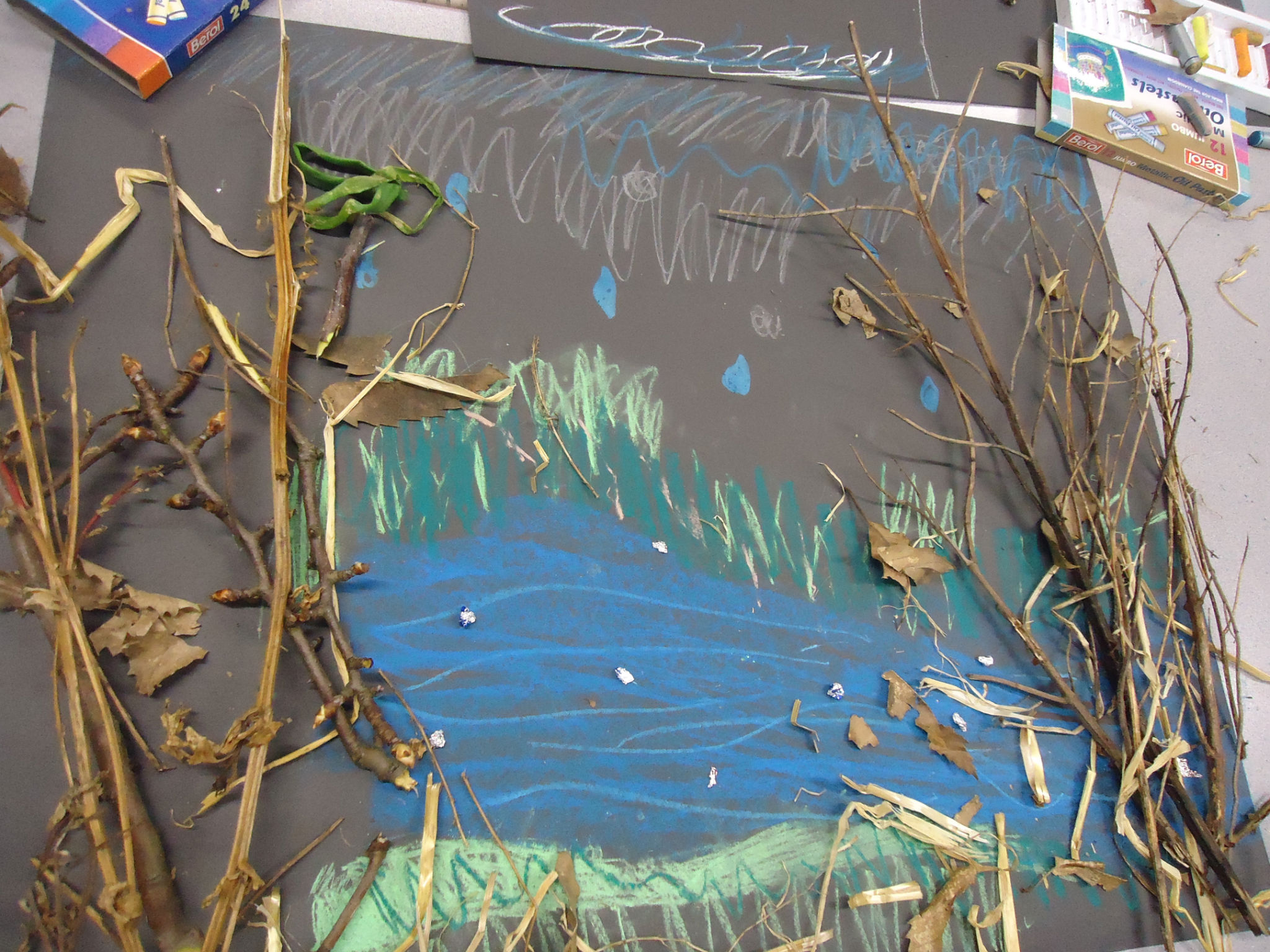 And they also learned about the water cycle, and how their bit of river fits into the wider geography of water movement – as illustrated by this picture below…
And they also learned about the water cycle, and how their bit of river fits into the wider geography of water movement – as illustrated by this picture below…
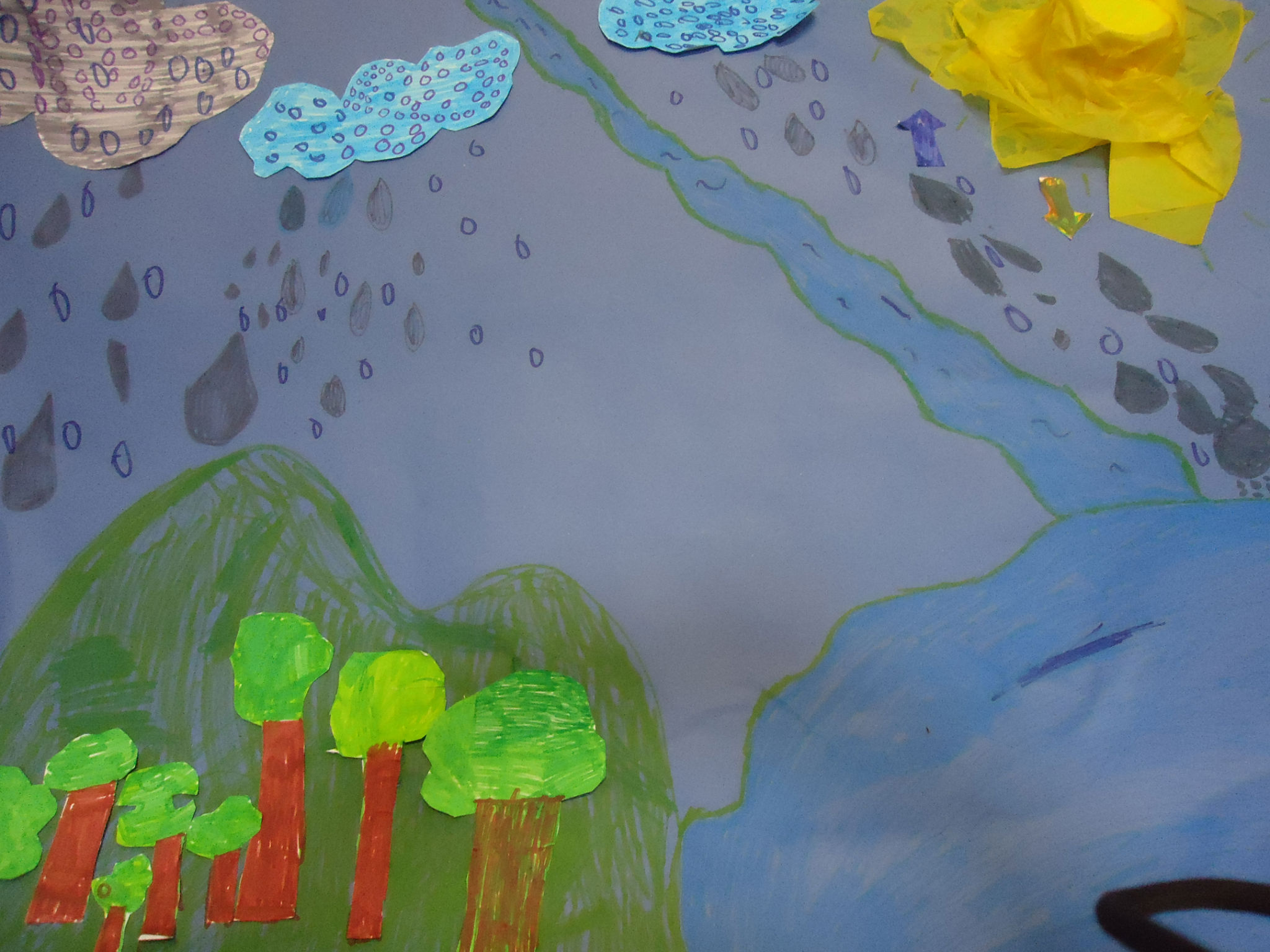 They also did some really amazing expressive writing, some of it in semi-pictorial form, like this piece below… from which I directed lifted quite a bit of the wording, to weave into our performance text…
They also did some really amazing expressive writing, some of it in semi-pictorial form, like this piece below… from which I directed lifted quite a bit of the wording, to weave into our performance text…
 The raindrop is “falling from the sky” to “meet my destiny”, while the river is saying “come on, come on”, welcoming it down: “I’m here for you and I always will be…” (There’s a pretty profound sense of ecological consciousness in there that adults might do well to think about!) Finally, the kids also did some imagining of fictional creatures that might live in or around the river, like this scary looking fellow…
The raindrop is “falling from the sky” to “meet my destiny”, while the river is saying “come on, come on”, welcoming it down: “I’m here for you and I always will be…” (There’s a pretty profound sense of ecological consciousness in there that adults might do well to think about!) Finally, the kids also did some imagining of fictional creatures that might live in or around the river, like this scary looking fellow… 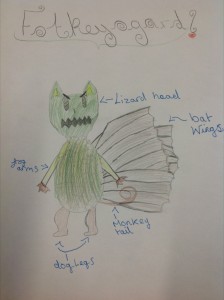 This gave me the idea to use some fantastical creatures in our performance – hence the “Sewage Goblins”, the “Elves of Industrial Effluent” and “the Foul Flies of Fly Tipping” – for which the children also made masks to perform in. These three groups (the three class groups involved) were the hideous minions of “the Evil Queen of Concrete”, who has smothered Bradford Beck (“Just call me Brad”) and family of little Becks… “Moo-ha-ha-ha!”
This gave me the idea to use some fantastical creatures in our performance – hence the “Sewage Goblins”, the “Elves of Industrial Effluent” and “the Foul Flies of Fly Tipping” – for which the children also made masks to perform in. These three groups (the three class groups involved) were the hideous minions of “the Evil Queen of Concrete”, who has smothered Bradford Beck (“Just call me Brad”) and family of little Becks… “Moo-ha-ha-ha!”
The moo-ha-ha was the very distinctive, very funny laugh for the Evil Queen decided on by Neiha (sorry – not sure of correct spelling), from Miss Butler’s Crossley Hall class. She’s a very sweet, shy girl but she was brilliant as “Elvira” on Monday night – word perfect too! She brought her evil minions down from 3 directions on Brad Beck (Maneeb, a small but very feisty boy, again perfect for the part – and again I don’t know how to spell his name) and his family. The other speaking parts with lines to learn were “Hope” and “Dwayne” – Annam and Aiden from St. James – who appeared at the end of the play to exhort us all to do more to “be the friends of Bradford Beck…” – to clean it up and make it happy. (The script was originally Hope and Faith, but Mr. Wilson wanted us to use a boy, so…). These guys too were great. It was strange watching these speakers in the middle of the Mirror Pool because they seemed so far away in this big space: the radio mikes meant we could hear every word crystal clear, though, and none of them fluffed a line!
Most of the script (which you can read here, if you like) was written to be delivered by narrators – one from each of the three classes involved – who could read from clipboards and so didn’t need to memorise lines. Uzair and Laiba (from Crossley Hall) and Iqra (St. James) all did a tremendous job with this, again speaking steadily and clearly so that the whole narrative came across clearly even in the slightly windy conditions. The challenge in writing the script for them had been to create something that said something about the Bradford Beck system – its geography and its history, and potential flood risk – in a way that would be clear to the children and make sense coming from them as speakers. I think for the most part we managed this, and we had some very positive feedback from some of the conference people about how well we’d balanced the positives and negatives in thinking about the state of the river and its potential risks.
The trickiest part of the whole process, though, was the choreography. The Mirror Pool is a big space to work in, so I always knew we had to make something that was primarily visual and movement-based (with music, narration and fountains…). I was lucky enough to be able to bring in Lucy Hind, a really wonderful movement director (worked on the Paralympic opening ceremony last year!) who was great with the kids and fun to collaborate with. It was very interesting to watch her gauging what the kids could cope with, movement-wise, and adapting accordingly. Our problem, though, was that we had quite limited rehearsal time at the schools (quite rightly – they have other things to be teaching these children!), and that we had extremely limited rehearsal time actually on site at the Mirror Pool… The first time the kids came together to work on it there was after school on Monday, shortly before we performed for our audience. So the results, in all honesty, were a little bit more chaotic than Lucy and I hoped… We just hadn’t had the time to work out all the details on site, and the kids were getting distracted pretty easily by the opportunity to splash about! (well they would, they’re 9 and 10!). What they lacked in rigorously drilled precision, though, they more than made up for in enthusiasm and energy, especially when it came to the splashing. And there were some sections of the show that looked really great – with the three classes stretched out along the three arms of the “Y” path that cuts across the pool, all twirling round, stamping feet, raising arms, etc. It’ll be fascinating to see how the pictures turn out…
I was also pleased to see that my “river trains” idea worked out OK. In this bit, different groups of children – linked in ‘conga’ lines with hands on shoulders – converged on the middle of the space from different directions, in a sort of mapping out of how the different tributary becks flow into Bradford Beck. The idea was that we’d locate the city centre in the middle of this map with a mini version of the Mirror Pool itself and the buildings around it (made by the children from boxes etc.). Unfortunately, the wind caught some of the models, and the kids carrying them had too much ground to cover for the narration to gel with what they were doing… But the big long river train came together beautifully. Geographically speaking, it ended up heading off somewhere towards “Leeds” instead of “north” towards “Shipley”, but I’m sure I was probably the only person watching who noticed this particular subtlety…
So, key learning point: children have less spatial awareness than you assume they will, especially in a big space. They’ll also naturally group together to feel safer when exposed, so instructions like “spread out across the space” are largely lost on them. (Maybe these are concepts that we grow into as we get older.) All that said though, I think these children did an amazing job considering the limited time we had and the scale of the task we gave them! And most important of all, they really seemed to have fun on the day, especially during the bit where they got to go bonkers in the water.
So thankyou Lucy, thankyou Mr. Wilson, Miss Taylor and Miss Butler, and thankyou most of all the Year 5 children of Crossley Hall and St James (some of whom I have become very fond of, and will miss!). All in all, it was quite an experience, and a lot of fun too!














